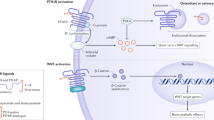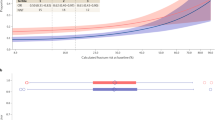Abstract
Bisphosphonates are potent antiresorptive agents, which have largely been used for the treatment of postmenopausal osteoporosis during the past 10 years. When embedded in bone matrix, bisphosphonates are taken up by osteoclasts engaged in bone resorption, leading—mainly by inhibition of farnesyl diphosphate synthase, a key enzyme of the mevalonate pathway—to osteoclast apoptosis. Bone resorption decreases, with consequent improvement in the mechanical properties of bone and a reduced risk of fracture. Alendronate and risedronate are oral nitrogen-containing bisphosphonates. Several randomized, placebo-controlled trials have shown the ability of these bisphosphonates to halve the risk of vertebral fracture when taken daily for 3 years. Nonvertebral fracture risk, including that at the hip, was also significantly decreased. Weekly regimens have simplified the administration of bisphosphonates and, probably, improved adherence to treatment. A significant reduction in the risk of vertebral fracture has also been demonstrated with an intermittent regimen of ibandronate, which is a new, potent, nitrogen-containing bisphosphonate. Ibandronate was recently marketed for use in an oral, once-monthly dose of 150 mg, with the goal of improving compliance. Bisphosphonates are usually well tolerated in the long term. Intravenous administration of bisphosphonates in women with osteoporosis, which is currently under investigation, might be an interesting future option for women who cannot tolerate oral regimens, and for enhancing compliance.
Key Points
-
Bisphosphonates are the most widely used drugs in the treatment of osteoporosis
-
In postmenopausal women, bisphosphonates halve the osteoporotic fracture rate
-
Bisphosphonates are well tolerated, but long-term adherence to treatment is poor
-
Intermittent regimens could improve compliance
-
New intermittent regimens with intravenously administered bisphosphonates are under investigation
This is a preview of subscription content, access via your institution
Access options
Subscribe to this journal
Receive 12 print issues and online access
$209.00 per year
only $17.42 per issue
Buy this article
- Purchase on Springer Link
- Instant access to full article PDF
Prices may be subject to local taxes which are calculated during checkout


Similar content being viewed by others
References
Fleisch HA (ed.; 1997) Bisphosphonates in Bone Disease. In From the Laboratory to the Patient, edn 3. New York: Parthenon Publishing
Russell RGG et al. (1999) Bisphosphonates: pharmacology, mechanisms of action and clinical uses. Osteoporos Int 10 (Suppl 2): S66–S80
Papapoulos SE (2001) Bisphosphonates in the management of postmenopausal osteoporosis. In Osteoporosis, edn 2, 631–650 (Eds Marcus R et al.) San Diego: Academic Press
Lin JH et al. (1992) Renal handling of alendronate in rats. An uncharacterized renal transport system. Drug Metab Dispos 20: 608–613
Lin JH et al. (1993) The role of calcium in plasma protein binding and renal handling of alendronate in hyper- and hypocalcemic rats. J Pharmacol Exp Ther 267: 670–675
Riis BJ et al. (2001) Ibandronate: a comparison of oral daily dosing versus intermittent dosing in postmenopausal osteoporosis. J Bone Miner Res 16: 1871–1878
Tanko LB et al. (2003) Oral ibandronate: changes in markers of bone turnover during adequately dosed continuous and weekly therapy and during different suboptimally dosed treatment regimens. Bone 32: 687–693
Pedersen-Bjergaard U and Myhre J (1991) Severe hypocalcaemia after treatment with diphosphonate and aminoglycoside. BMJ 302: 295
Salo J et al. (1997) Removal of osteoclast bone resorption products by transcytosis. Science 276: 270–273
Rogers MJ et al. (1994) Inhibitory effects of bisphosphonates on growth of amoebae of the cellular slime mould Dictyostelium discoideum. J Bone Miner Res 9: 1029–1039
Frith JC et al. (1996) Clodronate and liposome-encapsulated clodronate are metabolized to a toxic ATP analog, adenosine 5′-β,γ-dichlormethylene triphosphate, by mammalian cells in vitro. J Bone Miner Res 12: 1358–1367
Luckman SP et al. (1998) Nitrogen-containing bisphosphonates inhibit the mevalonate pathway and prevent post-translational prenylation of GTP-binding proteins, including Ras. J Bone Miner Res 13: 581–589
Ridley AJ and Hall A (1992) The small GTP-binding-protein Rho regulates the assembly of focal adhesions and actin stress fibers in response to growth factors. Cell 70: 389–399
Dunford JE et al. (2001) Structure-activity relationships for inhibition of farnesyl diphosphate synthase in vitro and inhibition of bone resorption in vivo by nitrogen-containing bisphosphonates. J Pharmacol Exp Ther 296: 235–242
Vitte C et al. (1996) Bisphosphonates induce osteoblasts to secrete an inhibitor of osteoclast-mediated resorption. Endocrinology 137: 2324–2333
Plotkin LI et al. (1999) Prevention of osteocyte and osteoblast apoptosis by bisphosphonates and calcitonin. J Clin Invest 104: 1363–1374
Giuliani N et al. (1998) Bisphosphonates stimulate formation of osteoblast precursors and mineralized nodules in murine and human bone marrow cultures in vitro and promote early osteoblastogenesis in young and aged mice in vivo. Bone 22: 455–461
Chavassieux PM et al. (1997) Histomorphometric assessment of the long-term effects of alendronate on bone quality and remodeling in patients with osteoporosis. J Clin Invest 100: 1475–1480
Boivin GY et al. (2000) Alendronate increases bone strength by increasing the mean degree of mineralization of bone tissue in osteoporotic women. Bone 27: 687–694
Nancollas GH et al. (2005) Novel insights into actions of bisphosphonates on bone: differences in interactions with hydroxyapatite. Bone [doi: 10.1016/j.bone.2005.05.003]
McClung M et al. (1998) Alendronate prevents postmenopausal bone loss in women without osteoporosis. Ann Int Med 128: 253–261
Liberman UA et al. (1995) Effect of oral alendronate on bone mineral density and the incidence of fractures in postmenopausal osteoporosis. N Engl J Med 333: 1437–1443
Black DM et al. (1996) Randomised trial of effect of alendronate on risk of fracture in women with existing vertebral fractures. Lancet 348: 1535–1541
Cummings SR et al. (1998) Effect of alendronate on risk of fracture in women with low bone mineral density but without vertebral fractures. JAMA 280: 2077–2082
Ensrud KE et al. (1997) Treatment with alendronate prevents fractures in women at highest risk. Arch Int Med 157: 2617–2624
Nevitt MC et al. (2000) Effect of alendronate on limited-activity days and bed-disability days caused by back pain in postmenopausal women with existing vertebral fractures. Arch Int Med 160: 77–85
Rizzoli R et al. (2002) Two-year results of once-weekly administration of alendronate 70 mg for the treatment of postmenopausal osteoporosis. J Bone Miner Res 17: 1988–1996
Bone HG et al. (2004) Ten years' experience with alendronate for osteoporosis in postmenopausal women. N Engl J Med 350: 1189–1199
Black DM et al. (2004) A 5 year randomized trial of the long-term efficacy and safety of alendronate: the FIT Long-term Extension (FLEX). J Bone Miner Res 19 (Suppl 1): S45
Bauer DC et al. (2005) Increased bone turnover after discontinuing alendronate predicts bone loss over 5 years: the FLEX Study. J Bone Miner Res 20 (Suppl 1): S95
Recker RR et al. (2004) Normal bone histomorphometry and 3D microarchitecture after 10 years of alendronate treatment of postmenopausal women. J Bone Miner Res 19 (Suppl 1): S45
Harris ST et al. (1999) Effects of risedronate treatment on vertebral and nonvertebral fractures in women with postmenopausal osteoporosis. JAMA 282: 1344–1352
Reginster J-Y et al. (2000) Randomized trial of the effects of risedronate on vertebral fractures in women with established postmenopausal osteoporosis. Osteoporos Int 11: 83–91
McClung MR et al. (2001) Effect of risedronate on the risk of hip fracture in elderly women. N Engl J Med 344: 333–340
Mitchell DY et al. (2000) Dose-proportional pharmacokinetics of risedronate on single-dose oral administration to healthy volunteers. J Clin Pharmacol 40: 258–265
Brown JP et al. (2002) The efficacy and tolerability of risedronate once a week for the treatment of postmenopausal women. Calcif Tissue Int 71: 103–111
Mellström DD et al. (2004) Seven years of treatment with risedronate in women with postmenopausal osteoporosis. Calcif Tissue Int 75: 462–468
Watts NB et al. (2004) Effect of risedronate treatment discontinuation on bone turnover and BMD. Calcif Tissue Int 74 (Suppl 1): S79
Ste-Marie LG et al. (2004) Five years of treatment with risedronate and its effects on bone safety in women with postmenopausal osteoporosis. Calcif Tissue Int 75: 469–476
Tanko LB et al. (2003) Oral weekly ibandronate prevents bone loss in postmenopausal women. J Int Med 254: 159–167
Chestnut CH III et al. (2004) Effects of oral ibandronate administered daily or intermittently on fracture risk in postmenopausal osteoporosis. J Bone Miner Res 19: 1241–1249
Miller PD et al. (2005) Monthly oral ibandronate therapy in postmenopausal osteoporosis: 1-year results from the MOBILE Study. J Bone Miner Res 20: 1315–1322
Recker RR et al. (2004) Insufficiently dosed intravenous ibandronate injections are associated with suboptimal antifracture efficacy in postmenopausal osteoporosis. Bone 34: 890–899
Adami S et al. (2004) Efficacy and safety of ibandronate given by intravenous injection once every 3 months. Bone 34: 881–889
Reid IR et al. (2002) Intravenous zoledronic acid in postmenopausal women with low bone mineral density. N Engl J Med 346: 653–661
Rosen CF et al. (2005) Treatment with once-weekly alendronate 70 mg compared with once-weekly risedronate 35 mg in women with postmenopausal osteoporosis: a randomized double-blind study. J Bone Miner Res 20: 141–151
Mashiba T et al. (2000) Suppressed bone turnover by bisphosphonates increases microdamage accumulation and reduces some biomechanical properties in dog rib. J Bone Miner Res 15: 613–620
Mashiba T et al. (2001) Effects of suppressed bone turnover by bisphosphonates on microdamage accumulation and biomechanical properties in clinically relevant skeletal sites in Beagles. Bone 28: 524–531
Komatsubara S et al. (2003) Long-term treatment of incadronate disodium accumulates microdamage but improves the trabecular bone microarchitecture in dog vertebra. J Bone Miner Res 18: 512–520
Allen MR et al. (2005) Risedronate and alendronate similarly suppress bone remodeling and increase microdamage in Beagles after 1 year of treatment at clinical doses. J Bone Miner Res 20 (Suppl 1): S22
Author information
Authors and Affiliations
Corresponding author
Ethics declarations
Competing interests
RD Chapurlat has received consulting or lecture fees from Eli Lilly and Novartis. PD Delmas has received consulting or lecture fees from Procter and Gamble, Sanofi-Aventis, Roche, Novartis, Eli Lilly, Nicomed, Wyeth, Pfizer.
Rights and permissions
About this article
Cite this article
Chapurlat, R., Delmas, P. Drug Insight: bisphosphonates for postmenopausal osteoporosis. Nat Rev Endocrinol 2, 211–219 (2006). https://doi.org/10.1038/ncpendmet0121
Received:
Accepted:
Issue Date:
DOI: https://doi.org/10.1038/ncpendmet0121
This article is cited by
-
Long-Term Oral Toxicity and Anti-osteoporotic Effect of Sintered Dicalcium Pyrophosphate in Rat Model of Postmenopausal Osteoporosis
Journal of Medical and Biological Engineering (2017)
-
Long-term effects of alendronate on fracture healing and bone remodeling of femoral shaft in ovariectomized rats
Acta Pharmacologica Sinica (2013)
-
Epidemiological aspects of rheumatoid arthritis patients affected by oral bisphosphonate-related osteonecrosis of the jaws
Head & Face Medicine (2012)
-
Is bisphosphonate therapy for benign bone disease associated with impaired dental healing? A case-controlled study
BMC Musculoskeletal Disorders (2011)
-
Cost of non-persistence with oral bisphosphonates in post-menopausal osteoporosis treatment in France
BMC Health Services Research (2011)



